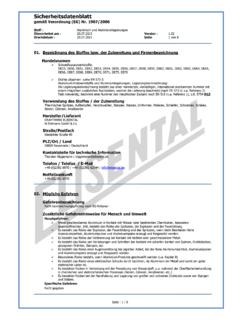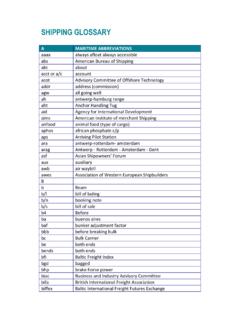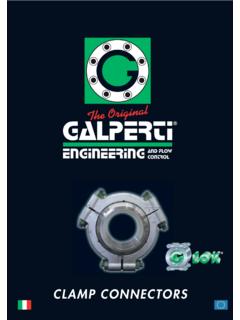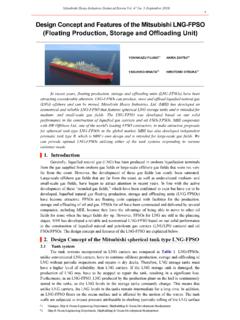Transcription of Schweißzusa?tze englisch außen:Layout 1 …
1 Welding fillersAluminium und Magnesium03/11-2000If the information provided here on- delivery packaging- materials- magnesiumhas already been removed, please contact us to obtain summaryMagnesiumMaterials summaryAluminiumForms of supplyAluminium and magnesiumUnlimited possibilitiesthanks to the all-rounder materials aluminium and magnesiumAluminium wire products aretoday virtually irreplaceable inall sectors of industry. Alloys which have been provenover decades, and newly-develo-ped and modified alloys have ex-tended the uses of the basic ma-terial so far that the possibilitiesfor using it are practically are stimulations tounlimited have ELISENTAL W. Erdmann GmbH & CoWerdohler Stra e 40 D-58809 NeuenradeTel.: +49(0) 23 92/697-0 Fax: +49(0) 23 92/69739e-mail: welding fillersMagnesium welding fillersexitL denscheidMitteSchwei zusa?
2 Tze englisch au en:Layout 1 10:12 Uhr Seite 1 Elisental, founded in 1919 andstill an independent companytoday, made the decision at avery early stage to specialise inaluminium, and is now one of theleading European producers ofaluminium some 40 years now, theproduction of aluminium weldingaccessories has been part of theproduct range. From the start, thisproduct group has been undercontinuous technical developmentin order to be able to respond tothe ever-increasing demands ofindustry. Thanks to many years ofintensive co-operation withsuppliers, we have been able tosecure extreme accuracy in thecomposition of our alloys,which leads to optimum levelsof stability with the smallestmeasuring tolerances. Modern drawing machinery,different peeling processes andnewly-developed cleaning processesall guarantee the outstandingweldability of our twist-free andlayer-spooled welding also take advantage of ourcomprehensive know how in thefield of drawing technology bybeing the first in the world topresent a completely drawnmagnesium large number of clearancesfrom different classificationbodies bear witness to theoutstanding wire are stimulationstounlimitedpossibilitiesAuto motiveShippingRailway vehiclesApparatus engineeringSports and leisureBuilding sectorTransportAeronautics27 Welding fillersSome sample uses for Elisental welding fillersWelding faultsCommonest causes of faults Poor arc or arc not striking at allFluctuating arcGrey-black seam surface, splashes formed, (more frequent in MIG welding)
3 Porous welding joints/ oxidation inclusions(more common in MIG welding)Faulty join (commoner in MIG welding)Welding seam cracksFaulty through-weldFaulty burn-inFusing or backfire (burning back) (only in MIG welding)Characteristics of correctly-formed welding seamsElectrical circuit interrupted, no earth connection, fault in the HF- or impulse generator, inadequate protective gas flowIrregular mains voltage, too low an idling voltage, capacitor fault, to large an electrode diameter, material too cold. Contaminated tungsten electrode throughcontact with melt materialInadequate welding current, contact by themelting welding rod with the air outside theprotection of the TIG seams are essentially a result ofproperly-adjusted welding parameters. Theyare to be recognised from a regular either side of the seam, there runs a nar-row, white (deoxidised) zone.
4 The seam sur-face is shiny and unlike MIG welding smoothand free of circuit interrupted, wrong pola-rity, fault in the cable ( , due to wear).Problems in the cable (wear, kinked wireelectrode, wiring set too bent), contact pipeworn positioning of the burner, arc too longFault on the surface of the welding filler,gas-jet heavily contaminated by splashing (care when using unsuitablenon-stick spray), wrong positioning of theburner, insufficient degassing of the weldfilling due to solidifying too fast (weldedtoo cold) wire feed-rate too slow, arc tooshort, intermediate surfaces dirty whenwelding several layers. (Welding filler-- 0too thin).If the wire feed is faulty or too smallcompared with the arc voltage, the wel-ding wire can melt back onto the bur-ner's copper jet. Good MIG seams are essentially a result of properly-adjusted welding parameters.
5 They demonstrate a regular finely-scaled seam with a cleantransition to the parent material. Thesplatter which sometimes appears on the surface can easily be brushed off. Causes in TIG welding Causes in MIG weldingProblems with the protective gas atmosphere ( , draught), leak in the cooling water orprotective gas pipework system, dirt in the vicinity of the seam or on the welding filler, jet too far distant, too little, too much and moist or impure protective causes above can to a great extent also be responsible for the formation of porousjoints (hydrogen bubbles) and oxidation seam-edge preparation (dirty, too sharp), inadequate preheating of the welding location and its vicinity (thick sheets not preheated), insufficient melting of base material (usually one side only) as a result of excessive welding speed or differing material thicknesses.
6 Incorrect welding filler, occurrence of excessive welding tensions and shrinking prevented by fabrication method (not ideal welding sequence), start and end cratercracks as a result of inadequate welding filler (where possible, locate the end crater on a run-out sheet or work with a crater filling program (MIG)).Too much or too little welding energy (voltage/welding filler feed), welding speed too fast or too slow with welding pool to hot or too cold, incorrect welding wrongly shaped, welding speed too high, arc too long, current supply not on protective gases:Argon-Helium-gas mixtures improve burn-in and on account of the higher heat introduction can help reduce the formation of proportions of oxygen or nitrogen in the gases - so-called "doped" protective gases - stabilise the arc, which can lead to finer drawing of the seam and reduction of sputter.
7 Schwei zusa?tze englisch au en:Layout 1 7:40 Uhr Seite 2DE 51DE 53DE 56DE 57DE 58DE 59DE 60DE 63DE 64DE 65S AL 1080 AS AL 1450S AL 5754S AL 5249S AL 5356S AL 4043 AS AL 4047 AS AL 5183S AL 5087S AL 5554DE 50DE 51DE 53DE 56DE 57DE 58DE 63DE 64DE 65S AL 1098 AS AL 1080 AS AL 1450S AL 5754S AL 5249S AL 5356S AL 5183S AL 5087S AL 5554DE 63DE 64S AL 5183S AL 5087 BVT VBWBR egistrationsSymbol of theRegistration authorityRegistrationsGermanischer LloydShipbuildingLloyd s Register of ShippingShipbuildingDet Norske VeritasShipbuildingAmerican Bureau of ShippingShipbuildingBureau VeritasShipbuildingDeutsche Bahn AGRail vehicle constructionTechnischer berwachungs-VereinContainer constructionFederal Office of Army ProcurementComponents subject to heavy wear for army materialPermissible welder-filler materialsDE 56DE 58DE 63DE 64S AL 5754S AL 5356S AL 5183S AL 5087DE
8 56DE 58DE 63DE 64S AL 5754S AL 5356S AL 5183S AL 5087DE 58DE 63DE 64S AL 5356S AL 5183S AL 5087DE 58DE 63DE 64S AL 5356S AL 5183S AL 5087DE 63S AL 5183 Numerical designationDNVABSDBS tages of manufacture DRAWING the aluminium wires is carried out on modernmultiple die drawing machines with exactly controlled diameterreductions. Using continuously-optimised drawing lubricantsand diamond drawing-dies, enables wires of the greatestaccuracy to be drawn. PEELING of the wires in the final stage of manufacture iscarried out in processes arranged in series. Here, a shavingprocess removes the original wire surface completely and asurface is produced which is absolutely essential for ahighquality welding wire. The FINAL TREATMENT of the wire surface takes place inmultistage ultrasonic-supported machines, using efficient andenvironmentally-friendly cleaning agents.
9 The purpose of this ison the one hand to remove the drawing/ peeling processresidues still adhering to the surface of the wire, and on theother hand assures a good sliding quality of the wire in thewire-conveyor systems of the welding plants. RESPOOLING of the finished welding wires onto the mostvaried types of spool is carried out on automatic spoolingmachines. Layered and twist-free spooling is regarded asstandard. Alongside the respoolers for welding wire, machinesfor spooling barrels are also in use,Delivery dimensionsPackaging Tolerances0,600,801,001,201,602,401,201, 601,602,002,403,204,005,006,00 SpoolsBarrelsRods+0,01-0,03+0,01-0,04+0, 01-0,04 0,10*36 Welding fillersOther dimensions on request. *no standardWelding fillersRecommendations for applicationSelection of type of welder-filler for the wrought or cast materials to be of the welding fillers from the corresponding type series (see table page 5) is finally used will be decided bythe actual welding task.
10 Please also observe the explanation given in the footnote below. Details within each box:1st. line =optimum mechanical properties2nd. line =optimum corrosion-resistance properties3rd. line =optimum weldabilityNo detail = no recommendationThe materials are listed corresponding to their chemical formulation and without regard to wrought or cast (base) : the type numbers 1, 2, 3, 4and 5match with the first figure of the numerical alloy designation. They areshown in bold classifications of the welding fillersStandard referencesDIN EN 573-3 Aluminium and aluminium alloys chemical compositionEN ISO 18273 Welding fillers - wire electrodes, wires and rods for welding aluminium and aluminium alloysDIN 1732-3 Filler metals for aluminium and aluminium alloys - Part3: Test pieces, test specimens, mechanical and technological properties of all-weld metalDIN EN ISO 544 Welding fillers - Technical delivery conditions for metallic welding fillersDIN EN 1011 - 4 Welding - recommendations for welding metallic materialsEUROCODE 9 Design, calculations and dimensioning of aluminium constructions subject primarily to dynamic stressesDIN V 4113 - 2 Aluminium construction under primarily static loadDIN EN ISO 9692 - 3 Welding and related processes - recommendations for types of jointsISO CD 10042 Arc-welding connections in aluminium and its alloys suitable for welding.






